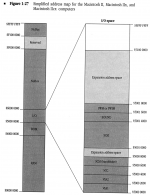(The original Apple technote is pretty misleading on this topic)
(This also applies to the Macintosh IIx, Macintosh IIcx, and Macintosh SE/30)
The original Macintosh II did not have a PMMU by default. It relied on the memory controller hardware to map the installed memory into a contiguous address space. This hardware had the restriction that the address space dedicated to bank A must be larger than those of bank B. Though this memory controller was designed to support up to 16MB 30-pin SIMMs for up to 128MB of RAM, the original Macintosh II ROMs had problems limiting the amount of RAM that can be installed to 8MB. The Macintosh IIx ROMs that also shipped with the FDHD upgrade fixed this problem, though still do not have a 32-bit Memory Manager and cannot boot into 32-bit addressing mode under Mac OS (without the assistance of MODE32). MODE32 contained a workaround that allowed larger SIMMs to be put in Bank B with the PMMU installed. In this case, the ROMs at boot think that the computer has 8MB or less of RAM. MODE32 then reprograms the memory controller to dedicate more address space to Bank A, allowing the additional memory in Bank B to be accessed. Since after that the physical address space is not contiguous, the PMMU is then use to remap the address space into a contiguous block.
(This also applies to the Macintosh IIx, Macintosh IIcx, and Macintosh SE/30)
The original Macintosh II did not have a PMMU by default. It relied on the memory controller hardware to map the installed memory into a contiguous address space. This hardware had the restriction that the address space dedicated to bank A must be larger than those of bank B. Though this memory controller was designed to support up to 16MB 30-pin SIMMs for up to 128MB of RAM, the original Macintosh II ROMs had problems limiting the amount of RAM that can be installed to 8MB. The Macintosh IIx ROMs that also shipped with the FDHD upgrade fixed this problem, though still do not have a 32-bit Memory Manager and cannot boot into 32-bit addressing mode under Mac OS (without the assistance of MODE32). MODE32 contained a workaround that allowed larger SIMMs to be put in Bank B with the PMMU installed. In this case, the ROMs at boot think that the computer has 8MB or less of RAM. MODE32 then reprograms the memory controller to dedicate more address space to Bank A, allowing the additional memory in Bank B to be accessed. Since after that the physical address space is not contiguous, the PMMU is then use to remap the address space into a contiguous block.
Last edited by a moderator:

